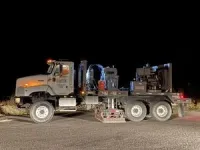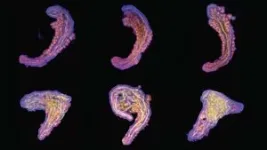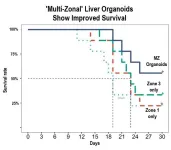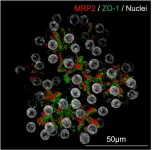(Press-News.org) Beneath Yellowstone lies a magma reservoir, pulsing with molten and superheated rock and exsolved gases. Scientists have long known about the chamber’s existence, but have yet to precisely locate its uppermost boundary and characterize the contents of the chamber closest to the surface—information crucial for understanding the potential perils this volcanic feature poses.
That changed this week with new research by seismologists from the University of Utah and the University of New Mexico (UNM) who used hundreds of portable seismometers and a mechanical vibration source to render 2D seismic reflection images of the ground beneath Yellowstone’s caldera.
Using artificial seismic waves, the team determined that the top of the chamber is 3.8 kilometers, or about 12,500 feet, below Earth’s surface, and it is sharply delineated from the rock strata above, according to findings published in the journal Nature. The researchers also determined the portion of the uppermost magma chamber that is comprised of volatile gases and liquids.
“The depth of 3.8 kilometers is important,” said coauthor Jamie Farrell, a U research associate professor of geology and geophysics and chief seismologist for the Yellowstone Volcano Observatory, operated by the U.S. Geological Survey. “We know what pressures are going to be and how bubbles are going to come out of the magma. One thing that makes these eruptions so devastating is that if gases are trapped, they become very explosive as they decompress.”
The good news is that these findings indicate the long-dormant Yellowstone Volcano is in no immediate danger of eruption.
This is because much of the volatile gas released from the magma escapes through Yellowstone’s surface geothermal features, such as Mud Volcano, without accumulating to dangerous levels, according to coauthor Fan-Chi Lin, professor in Utah’s Department of Geology & Geophysics.
“When the magma rises from the deeper crust, volatile materials such as CO2 and H2O exsolve from the melt. Due to their buoyancy, they tend to accumulate at the top of the magma chamber,” he said. “But if there’s a channel, they can escape to the surface.”
A high-silica type of igneous rock called rhyolite makes up Yellowstone’s magma chamber, which spans an area 55 miles by 30 miles, dropping to a depth of 10 miles below the surface. Beneath it is an even larger reservoir made of low-silica basalt and containing far less molten rock, according to a University of Utah study published in 2015 in Science.
The volcano blew catastrophically 630,000 years ago and many wonder if it’s getting ready for another eruption. Such fears are unwarranted, and the new findings are further evidence of that, according to Farrell.
For decades, scientists have studied Yellowstone’s intriguing magmatic system that drives the geysers, mudpots and thousands of other hydrothermal features that draw millions of visitors to Yellowstone National Park each year.
The U’s Seismograph Stations oversee a network of fixed seismometers at Yellowstone to monitor its frequent earthquakes. Seismic waves from these natural events have long helped scientists characterize the magma chamber, similar to the way CT scans image tissue inside the human body, but the representations are blurry. To achieve greater resolution in the new study, Farrell and Lin’s team deployed an array of 650 portable geophones along Yellowstone National Park’s roads at 100- to 150-meter intervals. Instead of waiting for earthquakes to happen, they brought in a Vibroseis truck, typically used in oil and gas exploration to image subsurface formations and deposits.
“In a sense, we're causing our own earthquakes, and we record all that data on the seismometers,” Farrell said. “And since we put so many out, we can get a higher resolution image of the subsurface.”
The team vibrated the ground at 110 locations, delivering 20 treatments lasting 40 seconds each.
Seismic waves propagate in two forms, known as S-waves and P-waves, which travel at different speeds and behave differently when they strike molten rock. Leveraging the properties of these waves, the researchers were able to locate the top of the chamber and determined that 86% of the upper portion is solid rock, with pore spaces comprising the remaining 14%. These pore spaces are about half filled with molten material and half with volatile gases and liquid, the researchers discovered.
This research is providing crucial clues about the structure of the magma body, according to USGS’s Mike Poland, the scientist in charge at the Yellowstone Volcano Observatory.
“That helps us understand more about the heat engine that's powering Yellowstone and about how melt is distributed. That can have ramifications for how we perceive the volcanic hazard,” he said. “Yellowstone in many ways is a laboratory volcano, and what we learn at Yellowstone can be used to better understand volcanoes in other parts of the world that are a lot more active, but are harder to study. Examples might be Campi Flegrei in Italy or Santorini in Greece, which is mostly submarine.”
He likened recent breakthroughs in seismic imaging to advances in digital cameras that have enabled vast leaps in photographic resolution. Prior studies, which relied on natural seismic events, led by Farrell, Lin, and other seismologists, pictured the magma chamber as an “amorphous blob” beneath Yellowstone. Now it’s coming into sharper focus with the help of artificially generated seismic waves.
“Over the years, different techniques have used the older data, and then there have been new data collection efforts like the one that in geoscientists from Utah and New Mexico that have allowed for increased resolution,” Poland said. “Similar techniques are being used in other places where you put out huge numbers of seismometers and then you record both the background earthquakes and you make your own seismic energy, which allows you to target specific things. These developments are allowing us to see into volcanoes in just really unprecedented ways.”
The study, titled “A sharp volatile-rich cap to the Yellowstone magmatic system,” was published April 16 In the journal Nature. The research was supported by grants from the National Science Foundation and the Brinson Foundation. Lead authors include Chenglong Dan and Wenkai Song of the University of New Mexico and Brandon Schmandt of Rice University.
about University of Utah’s geophysical research on the Yellowstone magma chamber and hydrothermal features.
U scientists plumb the depths of the world’s tallest geyser
A pool at Yellowstone is a thumping thermometer
Scientists see a deeper Yellowstone magma
END
Using vibrations to see into Yellowstone's magma reservoir
Utah geophysicists locate the top of the potentially explosive underground formation that drives Yellowstone's hydrothermal features
2025-04-16
ELSE PRESS RELEASES FROM THIS DATE:
From disorder to order: scientists rejuvenate aging batteries
2025-04-16
A team of scientists led by Prof. LIU Zhaoping at the Ningbo Institute of Materials Technology and Engineering (NIMTE) of the Chinese Academy of Sciences, in collaboration with researchers from the University of Chicago and other institutions, has developed zero thermal expansion (ZTE) materials. This innovation has achieved nearly 100% voltage recovery in aging lithium-ion batteries (LIBs), as detailed in a study published in Nature.
LIBs have become increasingly essential in the markets for electric vehicles and aircraft. Lithium-rich layered oxide cathode materials can deliver record capacities exceeding 300 mAh/g, thanks to revolutionary oxygen-redox (OR) ...
Metabolism shapes life
2025-04-16
New research from Barcelona and Dresden: Glycolysis — the process of converting sugar into energy — plays a key role in early development.
More than fuel: Glycolysis doesn’t just power cells — it helps steer them toward specific tissue types at critical moments in development.
Better embryo models: Stem-cell–based embryo models that rely on glycolysis form structures more similar to natural embryos.
Predict and control development in a dish: These findings improve our ability to predict and control how stem-cell-based embryo models will develop, ...
AI–enabled prediction of heart failure risk from single-lead electrocardiograms
2025-04-16
About The Study: Across multinational cohorts, a noise-adapted artificial intelligence (AI)-electrocardiogram (ECG) model estimated heart failure risk using lead I ECGs, suggesting a potential heart failure risk-stratification strategy requiring prospective study using wearable and portable ECG devices.
Corresponding Author: To contact the corresponding author, Rohan Khera, MD, MS, email rohan.khera@yale.edu.
To access the embargoed study: Visit our For The Media website at this link https://media.jamanetwork.com/
(doi:10.1001/jamacardio.2025.0492)
Editor’s ...
Immediate skin-to-skin contact in very preterm neonates and early childhood neurodevelopment
2025-04-16
About The Study: In this randomized clinical trial, 2 hours of mother-neonate skin-to-skin contact (SSC) in the delivery room did not enhance neurodevelopmental outcomes at 2 to 3 years of age. However, the SSC group demonstrated improved breastfeeding practices up to 12 months compared with standard care, suggesting that the feasible and low-cost SSC intervention should be encouraged in clinical practice.
Corresponding Author: To contact the corresponding author, Laila Kristoffersen, RN, PhD, email laila.kristoffersen@ntnu.no.
To ...
‘Cosmic radio’ could find dark matter in 15 years
2025-04-16
Scientists have designed a ‘cosmic radio’ detector which could discover dark matter in 15 years.
Published today in Nature, scientists at King’s College London, Harvard University, UC Berkley and others have shared the foundation of what they believe will be the most accurate dark matter detector to date.
Dark matter is the unobservable form of matter could make up as much as 85% of mass in the Universe, but scientists are not sure exactly what it is.
Axions are one of the leading ...
Supercharged mitochondria spark aging-related blood disorders
2025-04-16
As we age, blood stem cells, the essential source of new blood cells in the body, can accumulate genetic mutations. These mutations can give the cells a growth advantage, laying the foundation for developing serious health conditions. Now, scientists at The Jackson Laboratory (JAX) have not only discovered the mechanism that fuels their unchecked growth but have also found a way to stop it.
Led by Jennifer Trowbridge, professor and The Dattels Family Chair at JAX, the study reported today in the April 16 issue of Nature Communications reveals that a common aging-associated mutation in the gene Dnmt3a boosts the power-generating function of mitochondria ...
New human “multi-zonal” liver organoids improve injury survival in rodents
2025-04-16
One reason why our livers excel at clearing waste from our blood system is that the organ functions according to three key “zones” that perform specific major tasks. So, if scientists hope to create self-growing patches of liver organoid tissue that could help repair damaged organs, it’s important that the lab-grown tissue faithfully reproduce such zones.
In a groundbreaking paper published April 16, 2025, in the prestigious journal Nature, a team of organoid medicine experts at Cincinnati Children’s reports achieving just such a milestone – made from human stem cells. When these humanized organoids were transplanted into rodents whose own liver-bile duct system ...
Scientists achieve record-breaking growth in miniature, functional liver models
2025-04-16
Replicating the liver’s complexity
While organoids aim to mimic human organs, the liver’s repertoire of complex functions – and thus the energy it needs to operate – have made it challenging for researchers to grow organoids that proliferate and fully function, says Sato. When prioritizing growth and survival in laboratory settings, hepatocytes, the liver’s main cells, eventually transformed into cells resembling cholangiocytes, which line the bile duct. Hepatocyte functions only lasted 1-2 weeks at most.
The study team, led by Ryo Igarashi and Mayumi Oda at the Keio University School of Medicine, ...
Novel machine learning model can predict material failure before it happens
2025-04-16
A team of Lehigh University researchers has successfully predicted abnormal grain growth in simulated polycrystalline materials for the first time—a development that could lead to the creation of stronger, more reliable materials for high-stress environments, such as combustion engines. A paper describing their novel machine learning method was recently published in Nature Computational Materials.
“Using simulations, we were not only able to predict abnormal grain growth, but we were able to predict it far in advance of ...
Hereditary Alzheimer’s: Blood marker for defective neuronal connections rises early
2025-04-16
Individuals with a genetic predisposition to Alzheimer’s disease show altered blood levels indicating damaged neuronal contacts as early as 11 years before the expected onset of dementia symptoms. This is evident in the levels of the protein “beta-synuclein”. An international team, including researchers from DZNE, Ulm University Hospital and University Medicine Halle report these findings in the journal “Alzheimer’s & Dementia”. The biomarker studied here could potentially help to detect neurodegeneration at an early stage and thus ...
LAST 30 PRESS RELEASES:
New study overturns long-held model of how plants coordinate immune responses.
New AI model predicts disease risk while you sleep
Scientists discover molecular ‘reshuffle’ and crack an 80-year-old conundrum
How stressors during pregnancy impact the developing fetal brain
Electrons lag behind the nucleus
From fungi to brain cells: one scientist's winding path reveals how epigenomics shapes neural destiny
Schizophrenia and osteoporosis share 195 genetic loci, highlighting unexpected biological bridges between brain and bone
Schizophrenia-linked genetic variant renders key brain receptor completely unresponsive to both natural and therapeutic compounds
Innovative review reveals overlooked complexity in cellular energy sensor's dual roles in Alzheimer's disease
Autism research reframed: Why heterogeneity is the data, not the noise
Brazil's genetic treasure trove: supercentenarians reveal secrets of extreme human longevity
The (metabolic) cost of life
CFRI special issue call for papers: New Frontiers in Sustainable Finance
HKU Engineering scholar demonstrates the smallest all-printed infrared photodetectors to date
Precision empowerment for brain "eavesdropping": CAS team develops triple-electrode integrated functional electrode for simultaneous monitoring of neural signals and chemical transmitters during sleep
Single-capillary endothelial dysfunction resolved by optoacoustic mesoscopy
HKU three research projects named among ‘Top 10 Innovation & Technology News in Hong Kong 2025’ showcasing excellence in research and technology transfer
NLRSeek: A reannotation-based pipeline for mining missing NLR genes in sequenced genomes
A strand and whole genome duplication–aware collinear gene identification tool
Light storage in light cages: A revolutionary approach to on-chip quantum memories
Point spread function decoupling in computational fluorescence microscopy
BacPhase: Long-insert paired-end sequencing for bin marker construction and genome phasing
GmWOX1 regulates the mediolateral polarity of compound leaves in soybean
ChargeFabrica: An open-source simulation tool that aims to accelerate search for high performance perovskite solar cells
High levels of ADAR overexpression induce abundant and stochastic off-target RNA editing in rice protoplasts
On-demand upgraded recycling of polyethylene and construction of sustainable multifunctional materials based on the "LEGO" strategy
New "Stomata in-sight" system allows scientists to watch plants breathe in real-time
Anorexia nervosa may result in long-term skeletal muscle impairment
Narrative-based performance reviews deemed fairest by employees
New insights reveal how advanced oxidation can tackle emerging water pollutants
[Press-News.org] Using vibrations to see into Yellowstone's magma reservoirUtah geophysicists locate the top of the potentially explosive underground formation that drives Yellowstone's hydrothermal features








